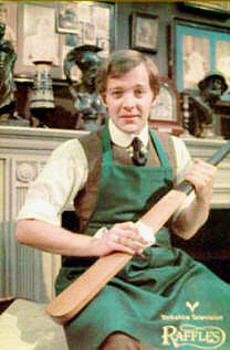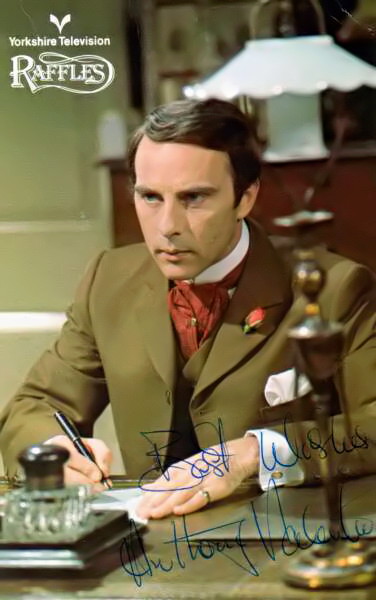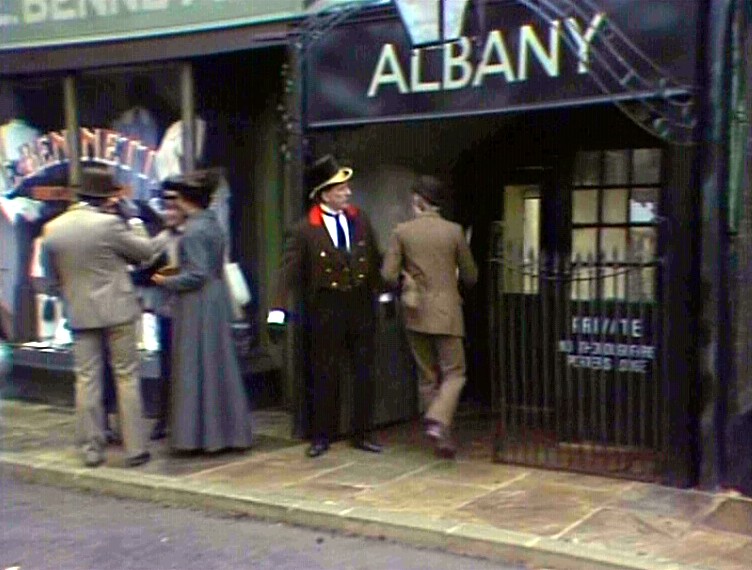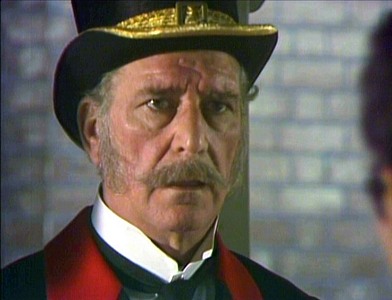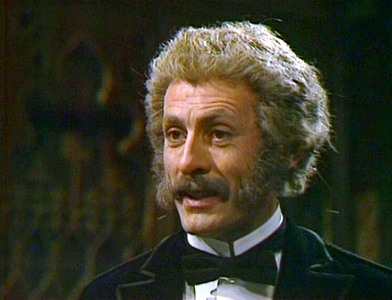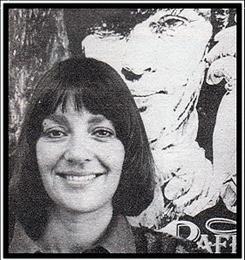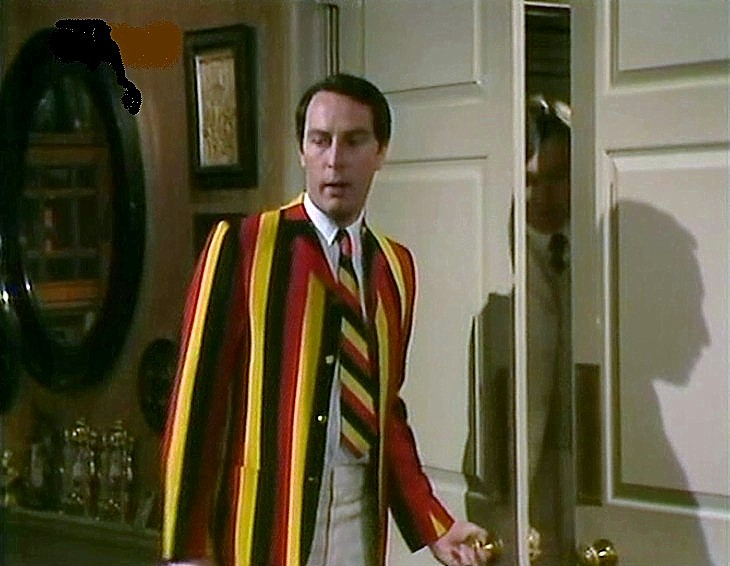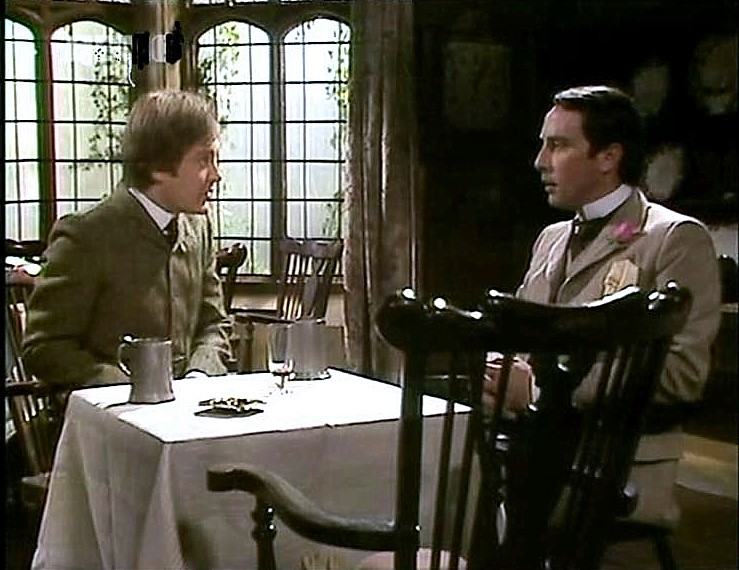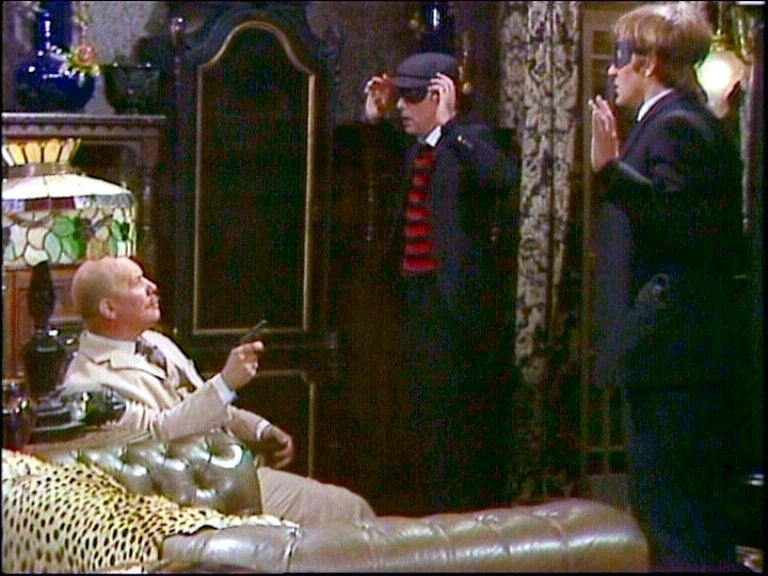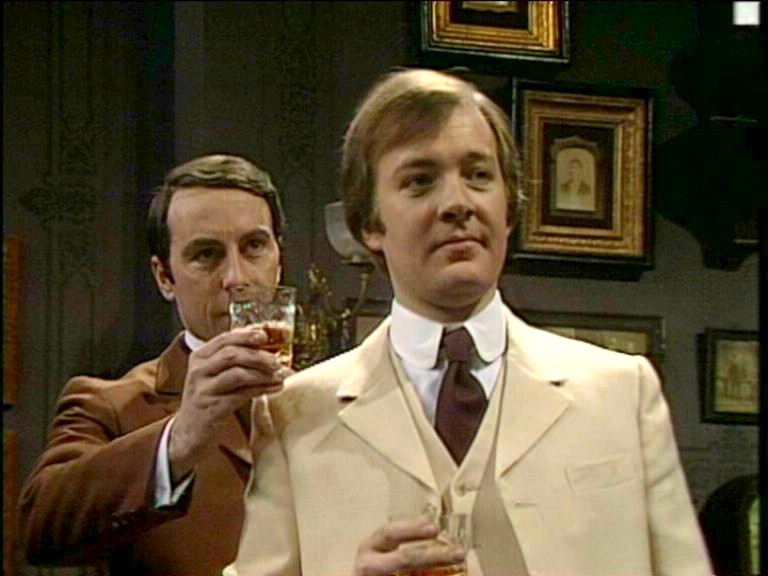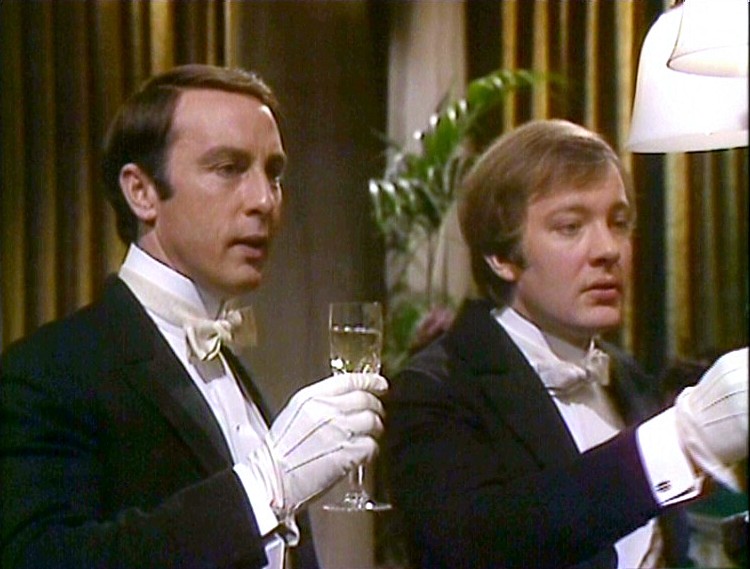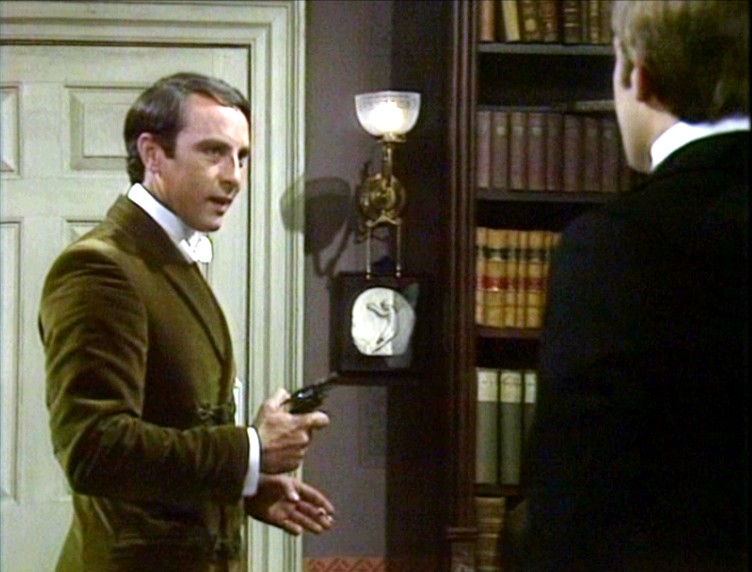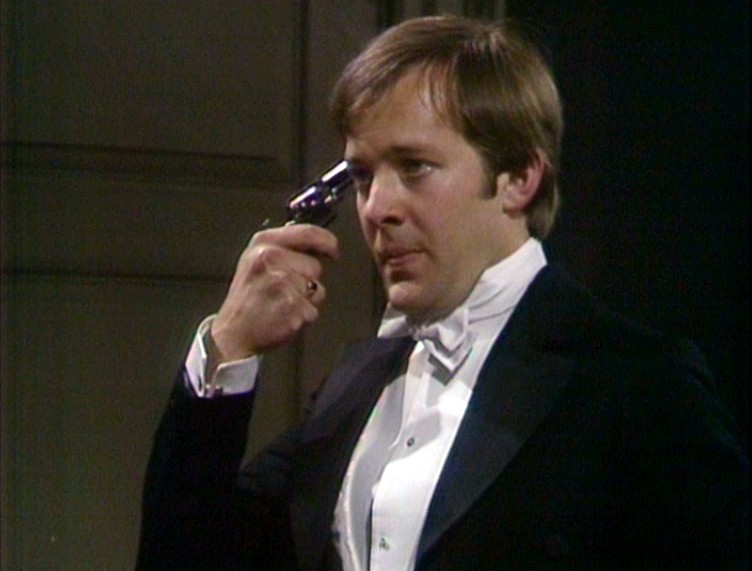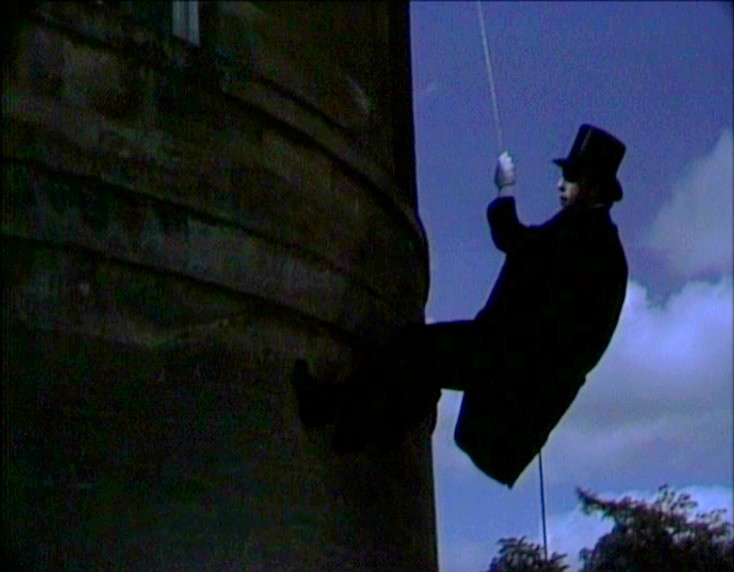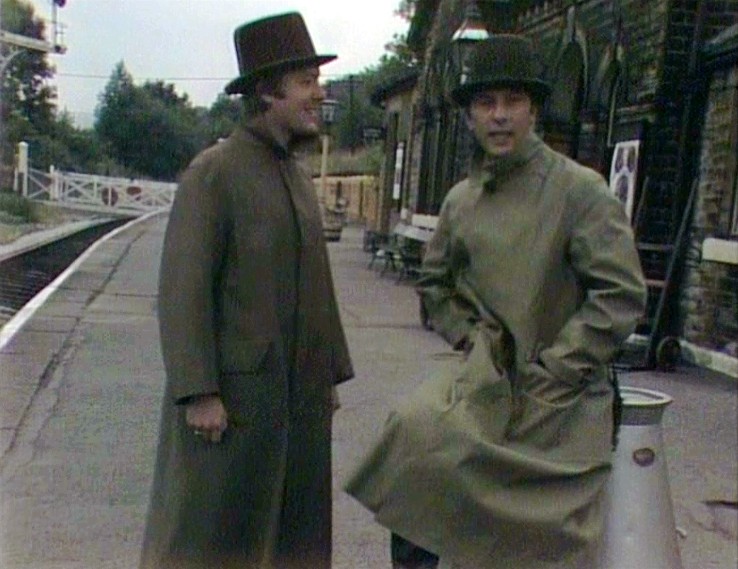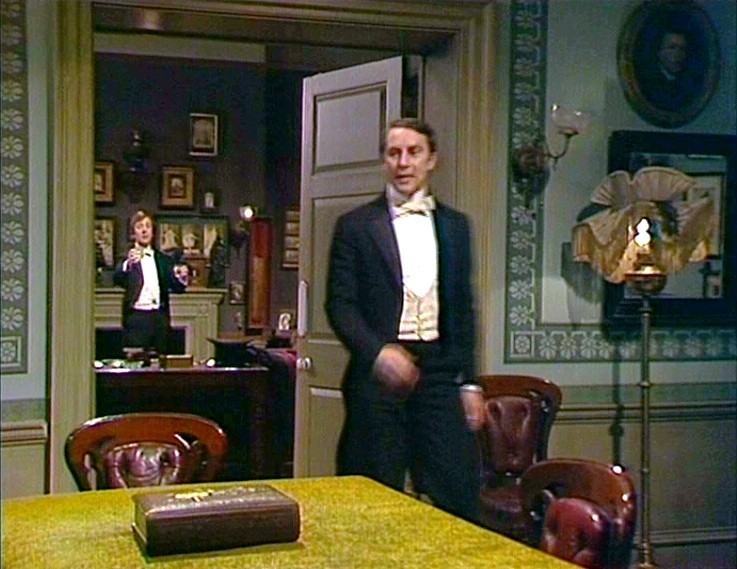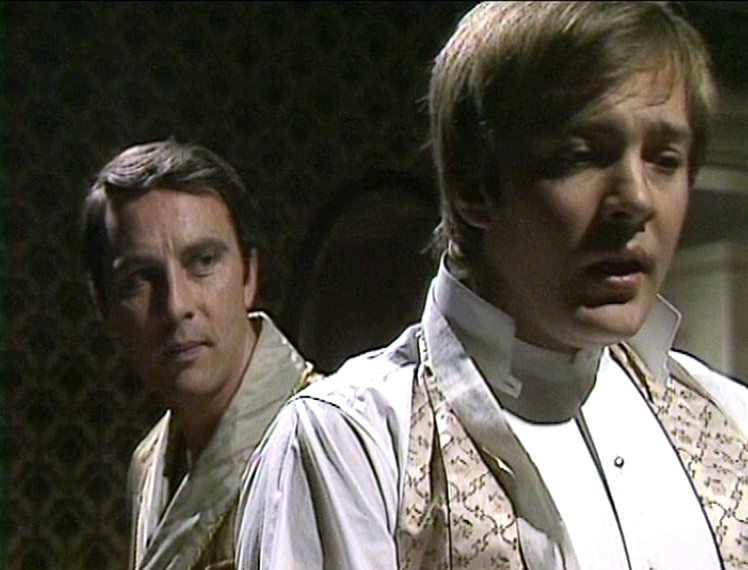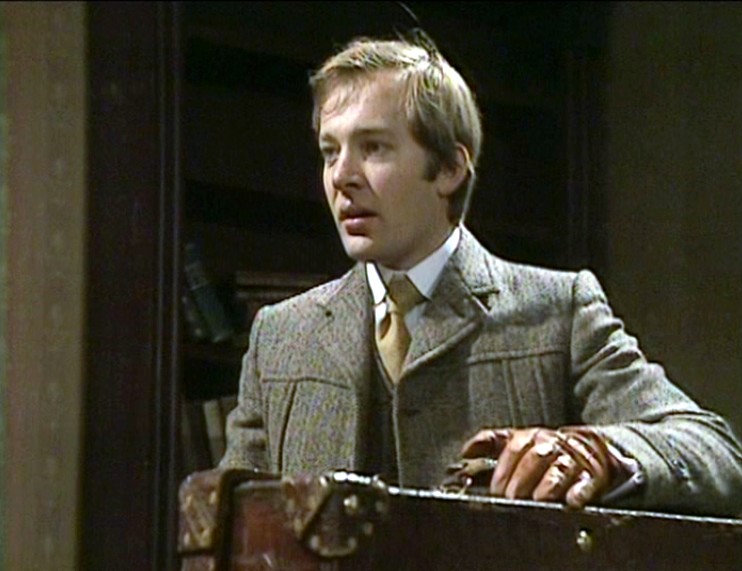RAFFLES
The Amateur Cracksman

Christopher Strauli who played Harry 'Bunny' Manders
Jacky Stoller
Producer of Raffles.
Anthony Valentine who played A.J. Raffles
Exterior shot of Yorkshire Television's design of London's exclusive Albany
Victor Brooks, who played
Beckett The Albany Hall Porter
Victor Carin who played Inspector Mackenzie of Scotland Yard
HISTORY OF THE 1976 SHOW
Raffles is a thirteen episode drama series which was made by Yorkshire Television for ITV in 1976-77. It was produced by Jacky Stoller.
Jacky was recommended the books of E.W. Hornung by a friend and after reading them, she suggested the idea of adapting them for television to the Head of Drama, Peter Willes. Willes immediately commissioned Philip Mackie to write the series. The directors were Christopher Hodson, Jim Goddard, John Davies, David Cunliffe and Alan Gibson with music by Anthony Isaac.
The budget was approximately 5 million pounds and the principal photography took six months. As most of the series took place in the Albany, Raffles' home in the exclusive enclave in the centre of London, it was imperative to film there.
However, the Albany wouldn't grant permission so Raffles' home, together with a replica of a London Victorian street was built in the grounds of a stately home in Yorkshire. A gaslit London Street was also recreated in Carlton House Terrace, Mayfair, London. It was the first time any television company had embarked on such an expensive enterprise. As the filming was done in the memorable hot 'Summer of '76' all the actors were sweltering in their heavy costumes and stiff collars.
Raffles was also played by Ronald Colman in the 1930s in a Hollywood film and by David Niven in a 1940 production which co-starred Olivia de Havilland. Today Raffles has a cult following with many websites devoted to his luxurious lifestyle as a gentleman and thief.
The music to the pilot episode, Gentlemen And Players is Dukas' 'The Sorcerer's Apprentice' and lacking a proper theme at this time it works well in establishing the mood of the piece. The story is based on the E.W. Hornung story of the same name which appears in the first novel in the canon, The Amateur Cracksman. From the outset we are aware of Raffles' and Bunny's social position. They are gentlemen but they are not from the higher echelons of the aristocracy. Raffles comments with some bitterness to Bunny that he 'hates being asked about for his cricket, hired for his cricket like one of the waiters', and the rooms they are given at the Earl of Milchester's are part of the servants' quarters, Bunny lodging in the maid's room while Raffles' room is only slightly better. At dinner Bunny is placed next to Miss Melhuish, the local vicar's daughter, who confides in him that she is only ever invited to make up an even number. The aristocracy themselves are presented as being rather vulgar and patronising - in the instance of Lady Margaret we are told that there is nothing to know about her except her love of champagne and her wealth, which allows her to indulge it. We are told that her necklace alone would keep a poor man alive for a couple of hundred years. Raffles himself seems able to transcend all classes - he is equally at home chatting with the friends of the Earl of Milchester and later with the thief Crawshay whom he admires for the daring way in which he breaks out of prison.
The next episode The First Step is chronologically out of order with Hornung's original stories; this was actually the very first story in the series when Raffles and Bunny become reacquainted after their days at the public school which they both attended. It is based on the story The Ides Of March, which appears in The Amateur Cracksman. We learn that Raffles' rooms are at No. 3 at The Albany when a desperate Bunny visits him after a break of about ten years, only to fall victim to a couple of card sharps whom Raffles was hoping to fleece himself. Bunny lives only a few streets away from Raffles, in Mount Street, Mayfair. Raffles is still Bunny's hero even after all this time, and it is obvious that Raffles is the one person to whom Bunny would have turned while in his present dilemma. Even when he threatens to commit suicide in Raffles' presence his threat is rather hollow, but Raffles senses that Bunny still has the right stuff in him, and decides that he would make a very good partner in crime. Thus begins their association, both as friends and fellow jewel thieves.
In A Costume Piece, which is based on the story of the same name in The Amateur Cracksman, E.W. Hornung pays a compliment to his brother-in-law, Arthur Conan Doyle by having one of the leading characters write his initials on the wall with a revolver just as Sherlock Holmes did in the short story The Musgrave Ritual when he used a gun to write Queen Victoria's initials into the wall of 221B Baker Street. Raffles and Bunny are no less patriotic towards Queen Victoria. Their devotion to their sovereign is absolute in this, her Diamond Jubilee year of 1897. We learn that like his fellow fictional creation of Sherlock Holmes, Raffles is a master of disguise and a wonderful actor with a mastery of accents second to none. Raffles has a small studio off the King's Road in which he keeps an array of costumes, and we learn that he considers himself not a mere criminal but an artist in crime; he does not simply steal like a common burglar, although the profits from his crimes do enable him to maintain his amateur status when playing cricket for England. For Raffles crime is mostly about the thrill of the chase, of the excitement which thumbing his nose at the law in the person of Inspector Mackenzie and conventional Victorian morality bring to him. It is important to him that, as in cricket, he 'plays the game' for Raffles is a gentleman and does not abandon his own code of ethics, however wildly at odds this differs from that of the wider community of Victorian England. It is interesting and somewhat entertaining that Inspector Mackenzie's clothes in this series resemble those of Sherlock Holmes, and Raffles at one point in this episode is actually engrossed in a copy of The Adventures of Sherlock Holmes. We also discover that Raffles went to Cambridge, and there is an echo of P.G. Wodehouse's school stories here when at one point in the story Raffles uses a policeman's helmet, which he had stolen on boat race night while at Cambridge, as a disguise to rescue Bunny. Similarly, Raffles' and Bunny's London Club, The Old Bohemians, if not quite The Drones Club, does bear a passing resemblance to that fictional haunt of the young man about town. There is something endearingly schoolboyish and ingenuous about this series, exactly like the free-spirited stories of E.W. Hornung upon which it was based.
The next episode, The Spoils Of Sacrilege, is based on the story of the same name which made its first appearance in Hornung's A Thief In The Night, the third novel in the canon. It is probably the most action packed boy's-own-paper yarn in the series, although we learn a great deal about Bunny Manders' background as a boy through the course of its telling. We learn that he came from an affluent family who were members of the country gentry, and had a youthful crush on the local rector's daughter Phyllida who, like her namesake from the old poem, flouted Bunny despite his best attempts at writing verse to her. Bunny is chafing because he feels that he is not contributing enough to his criminal partnership with Raffles, so it is agreed between the two of them that Bunny should take charge of this particular burglary which takes place at Bunny's old home, Pinfield Park, now the residence of Lord Osborne, a stout country gentleman who according to the fashion of the times indulges in fox hunting and is a sportsman at heart. Everything goes wrong under Bunny's leadership, of course, because he is not a natural born leader like Raffles. His great value in the team is his quality of genuine innocence; this, plus his courage, loyalty and decency are never in doubt. In this story Bunny is overcome by the horror of losing his honour, of being discovered at his old childhood home as a thief. So to preserve his childhood memories intact Bunny leaves the items of jewellery which he has stolen behind, believing that to take them would be sacrilegous to the memory of the boy he once was. It is a ripping yarn, with Lord Osborne and his guests draped in hunting pink and chasing the two unexpected guests all over the house amid hunting shouts and horns blaring, but it is also about a young man's search for, and discovery of, his identity.
It is apparent that Anthony Valentine as Raffles did his own stunts for the series. In this episode he abseills down the side of a building, decked out in a top hat and tails, and in the next episode, The Gold Cup we see him climbing easily up a rope to a second storey room. At the time one of his hobbies was climbing, and this stood him in good stead for his role as Raffles. He is also an accomplished rider, and this is portrayed in the episode The Gift Of The Emperor where Raffles is involved in a hunt. Christopher Strauli in character as Bunny is slightly less athletic, as Bunny is meant to be, but gives an extremely good account of himself in the horse riding scenes in The Gift Of The Emperor.
"'Cricket,' said Raffles, 'like everything else, is good enough sport until you discover a better. As a source of excitement it isn't in it with other things you wot of Bunny.... What's the satisfaction of taking a man's wicket when you want his spoons?"
Gentlemen and Players
".... my thoughts wandered with my eyes as the minutes passed. The room was the good-sized, square one, with the folding doors, the marble mantelpiece, and the gloomy, old-fashioned distinction peculiar to the Albany. It was charmingly furnished and arranged, with the right amount of negligence and the absence of the usual insignia of a cricketer's den. Instead of the conventional rack of war-worn bats, a carved oak bookcase, with every shelf in a litter, filled the better part of one wall; and where I looked for cricketing groups, I found reproductions of such works as 'Love and Death' and 'The Blessed Damozel,' in dusty frames and different parallels. The man might have been a minor poet instead of an athlete of the first water. But there had always been a fine streak of aestheticism in his complex composition; some of these very pictures I had myself dusted in his study at school; and they set me thinking of yet another of his many sides - and of the little incident to which he had just referred."
The Ides of March
The Gold Cup is based on two stories from the canon, A Jubilee Present which first appeared in Hornung's The Black Mask, the second novel in the canon, and The Criminologists' Club which made its first appearance in A Thief In The Night. In this episode we learn more about Arthur J. Raffles himself. We discover that he is a passionate lover of all beautiful things, including the St. Agnes Cup, a gold cup of singular beauty which has been donated to the British museum by the Earl of Thornaby. The cup has no market value whatsoever as it is too famous, but Raffles simply wants it so that he can admire it whenever he wishes. Disguised as an elderly man in a bath chair he visits the Museum with Bunny acting as his attendant; acting on impulse Raffles steals the gold cup, and he and Bunny make a successful getaway.
As well as being the original donator of the cup, Lord Thornaby is also the Chairman of the Criminologists' Club. He and his fellow members are beginning to suspect Raffles of being the successful high society cracksman who has stolen Lady Melrose's necklace and committed other society thefts. He invites Raffles and Bunny to dinner at his home, and it is here that we discover that Raffles loves all forms of risk-taking. He indulges in a verbal battle with Lord Thornaby and his fellow criminologists, who include a writer of detective fiction, a judge and a successful barrister and at one stage Bunny thinks that Raffles is actually on the verge of admitting to being the Cracksman quite openly. Just when things are starting to warm up nicely and it is beginning to look as though Raffles has gone too far it is discovered that the Cracksman has paid the Criminologists' Club a visit while they have been at dinner and has made off with Lord Thornaby's peers' robes and coronet, items which Thornaby will need for Queen Victoria's Jubilee Day. Guiltily Lord Thornaby offers to propose Raffles for membership to the exclusive Atheneum Club for gentlemen, and is extremely apologetic for suspecting him for one moment. What Lord Thornaby does not know is that Raffles had planned the burglary of his premises down to the last minute and has been playing The Criminologists' Club along, pushing their suspicions to the limit knowing full well that he has planned a perfect alibi which he can use to disarm his accusers at any moment he chooses. Raffles shows off unmercifully while he stirs up the Criminologists' Club, and later back at The Albany is equally pleased with himself when he models Lord Thornaby's peers' robes and coronet in front of an admiring Bunny. Later he sends them to the cloakroom at Charing Cross Station and mails the ticket to Lord Thornaby in time for Jubilee day. He also sends the Gold Cup to Queen Victoria as an offering from The Criminal Classes, thus ensuring that in this episode of his life, at least, he has stolen absolutely nothing but has enjoyed himself at the expense of the aristocracy, the law and society once again. Patriotic, proud, thrill seeking and as painstaking a planner of his crimes as he is at the game of cricket, Raffles possesses an iron nerve and is an aesthete with a lust for life, who nevertheless disguises his passionate nature beneath an ice-cold exterior.
The Chest Of Silver is based on the Hornung story of the same name which first appeared in A Thief In The Night. We find Raffles keeping poor Bunny in the dark throughout most of the story, knowing full well that an ignorant Bunny is more likely to show a face of blissful ignorance to a hostile world, and to Scotland Yard and Inspector Mackenzie in particular. When Bunny shows that he resents this, Raffles tests him to the utmost, leading a nervous Bunny to confess that sometimes he really does prefer blissful ignorance to guilty knowledge after all.
Although we had had a brief glimpse of it in The Spoils of Sacrilege, we are treated to more of a glimpse of Nevill's Turkish Baths in Northumberland Avenue in this episode, a site frequented not only by Raffles and Bunny, but also by Sherlock Holmes and Dr. Watson. In real life both E.W. Hornung and Conan Doyle had visited this establishment which was extremely popular in Victorian London, opening in 1884 and only closing its doors in 1948. Hornung described its pleasures in The Chest Of Silver with Bunny as narrator thus:
"In my dilemma I did what I have often done when at a loss for light and leading. I took hardly any lunch, but went to Northumberland Avenue and had a Turkish bath instead. I know nothing so cleansing to mind as well as body, nothing better calculated to put the finest possible edge on such judgment as one may happen to possess. Even Raffles, without an ounce to lose or a nerve to soothe, used to own a sensuous appreciation of the peace of mind and person to be gained in this fashion when all others failed. For me, the fun began before the boots were off one's feet; the muffled footfalls, the thin sound of the fountain, even the spent swathed forms upon the couches, and the whole clean, warm, idle atmosphere, were so much unction to my simpler soul. The half-hour in the hot-rooms I used to count but a strenuous step to a divine lassitude of limb and accompanying exaltation of intellect. And yet—and yet—it was in the hottest room of all, in a temperature of 270º Fahrenheit, that the bolt fell from the Pall Mall Gazette which I had bought outside the bath. I was turning over the hot, crisp pages, and positively revelling in my fiery furnace, when the following headlines and leaded paragraphs leapt to my eye with the force of a veritable blow: BANK ROBBERS IN THE WEST END—DARING AND MYSTERIOUS CRIME...
I determined to go through with my bath and make the most of it. Might it not be my last for years?
But I was past enjoying even a Turkish bath. I had not the patience for a proper shampoo, or sufficient spirit for the plunge. I weighed myself automatically, for that was a matter near my heart; but I forgot to give my man his sixpence until the reproachful intonation of his adieu recalled me to myself. And my couch in the cooling gallery—my favorite couch, in my favorite corner, which I had secured with gusto on coming in—it was a bed of thorns, with hideous visions of a plank-bed to follow!"
The Chest Of Silver also introduces several new contraptions which were new to Victorian London - the telephone and the electric light, both of which Raffles has installed into his rooms at The Albany while he is 'away' improving his accent in Scotland. It is intriguing watching the scene of an enraptured Raffles playing with the light switch and enquiring of the electrician how many candles it represents. Upon receiving the response that it is about a thousand, Raffles replies that he must bring only ladies with perfect complexions to his rooms. It must have been an exciting innovation to the Victorians; it was a technologically innovative age, much as the era in which we are now living is to us with many new inventions changing the face of society with astonishing rapidity. Despite having reservations about the telephone which he has just had installed, Raffles takes a child like delight in ringing Inspector Mackenzie and talking to him with a thick Scottish accent, supposedly picked up from the Rhinns of Galloway. A delightful addition to the Raffles series, made all the more so because it did not deviate very much from the original story written by E.W. Hornung. (To be continued).....
1. A body massage using soap and water.
2. A swim in cold water often followed the heat of the Turkish bath.
2
1
